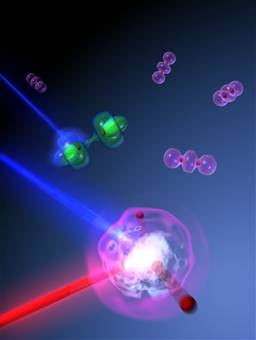Oct 26 2008
Air Force Office of Scientific Research-funded work at the University of Colorado at Boulder could lead to possible future technologies that use the high energy densities of lasers.
 Ultrafast flashes of X-rays can eject an electron from a molecule, leaving the molecule in a super excited state that eventually causes it to break apart. The interaction of atoms and molecules is both useful for making coherent X-rays which, in the future, may show previously undetectable cracks in jet turbine blades. (Courtesy image)
Ultrafast flashes of X-rays can eject an electron from a molecule, leaving the molecule in a super excited state that eventually causes it to break apart. The interaction of atoms and molecules is both useful for making coherent X-rays which, in the future, may show previously undetectable cracks in jet turbine blades. (Courtesy image)
Studies by university officials explore how atoms and molecules respond to light pulses, which could show cracks in high-performance engines.
The husband and wife research team of Dr. Henry Kapteyn and professor Margaret Murnane has developed new, practical, laser-like sources in the ultraviolet and soft X-ray regions based on the most extreme form of nonlinear optics.
In this work, an intense femtosecond laser is focused into a gas-filled hollow waveguide. The interaction between the laser field and the atoms in the gas is so strong that electrons are violently accelerated, and then liberate their energy as a coherent beam of X-rays.
Ultrafast coherent beams of X-rays have a myriad of applications in technology and science -- from next-generation microscopes that have the capability to image thick samples in 3-D, to understanding how heat flows in nanostructures or how electrons move at interfaces relevant to energy harvesting.
This research impacts the Air Force by making ultrafast lasers useful in remote sensing, missile defense and adapted optics. The femtosecond lasers that the couple develops to power the X-ray source are also used in micro-machining and may be applied to aircraft aerodynamics and high-performance engines.
"Our research straddles the boundary between laser science and technology," Ms. Murnane said. "We take ideas all the way from conception to integration in systems that can then be used by other scientists. This takes a team of physicists, engineers and chemists all working together. We discovered that the interaction of atoms and molecules is both useful for making coherent X-rays which, in the future, may image previously undetectable cracks in jet turbine blades."
A major future challenge is to find ways of generating coherent X-ray beams which require the scientists to control quantum phenomena at very high laser intensities. The challenges have also yielded new demands on the technology the couple uses to meet their goals.
"After a number of years of exploiting the laser technology that we already developed, we are now planning a new push for high-power laser technologies," Ms. Murnane said.